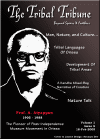Nature Talk
|
The ‘Tribal Tribune: Beyond Feathers and Arrows’ consider it a proud privilege to dedicate this February 2005 number to the memory of Professor A. Aiyappan, who was born in this month in 1905. As this net-magazine is devoted to the cause of tribal people, it will be most appropriate to pay homage to the late scholar Prof. A. Aiyappan, who opted for research in anthropology, after obtaining Master Degree in Zoology. While carrying out doctoral research in Britain, his interest in tribal studies was inspired by legendary scholars like Bronislaw Malinowski and Raymond Firth, both of them came to anthropological discipline from different back grounds. This amalgamation of knowledge from various disciplines, could allow wide-angled view to study human world. Aiyappan,s academic compatriots included E. Evanspritchard who introduced the African tribal communities through classic ethnographic syudy, L.S.B. Leakey, who discovered the famous fossil hominids and established African claim for human evolution, Cora Dubris, H.D. Saukhalia, and many others. Aiyappan spent major part of his work life in the State Museum in Chennai (Madras).so most of his research works are related to the south Indian tribal communities. When he moved to Utkal University in Bhubaneswar to take up responsibilities of a nascent post graduate teaching department of anthropology, his field studies were expanded to the tribal areas of Orissa. He retried from the University services in 1996 and again moved to Thiruvanthapuram (Trivandram) to assume the duties of Vice Chancellor. Elevation to coveted posts may be lucrative, but do not secure a place in the enviable academic school of con tributors to knowldge. The readers of present generation would prefer to be aquinted with academic contribution of Professor Aiyappan. Prof. Aiyappan was a complete anth5ropologist in true sense of the term. His activites were not limited in only the sub field of social anthropology or ethnography. He greatly pioneered the mesum movement and wrote a book on museology and museum preservation methods, the most compitent in mid-twentieth century. Unlike other social antthropologists, Aiyappan studied genetic and morphometric variation in Wyand area and prehistoric cultures of Suth India. His close association with renound archeologists like V. D. Krishnaswamy, Subba Rao, Sankhia and even Mortimor Wheeler, indicate his deep interest in prehistoric and proto-historic cultures. In many articles he has tried to find the evolutionary continum of people in India, tracling the problem from linguistic, ritualistic, social practices and biological traits. This was uncommon in his time of mid-twentieth century. The prosterity will wonder from the vastness of the areas where professor Aiyappan has expressed his inquisitiveness on human life. He composed his articles with such élan and simplicity of language, that these could be understood by any layman. Aiyappan did show little interest in theorizing his observations like his contemporary renowned scholars, but tried to extricate the inner details from which generalization can be arrived easily. Once he was asked by his American friends (in early sixties of last century) about the secret of family piece in India in spite of poverty, and for which his curt reply was, general Hindu couple gave immense value to the rituals of marriage, the promise before sacred fire ("homa"). A couple will prefer quarrel but not think of divorce. Marriage matches are believed to be predetermined. Such fundamental observation and deep introspection, characterized Professor Aiyappan. His class room teaching was never piece-meal incidents of people’s life and developing these into anthropological interpretation. Probably for these reasons, I was attracted to anthropological science in a holistic manner, combining all the approaches. Writings of Prof. Aiyappan was very lucid and wrinkle-free, so that the meaning is conveyed easily to the reader who is not conversant with jargons. |
Photographs :
References :



